Hyundai Motor Bundle
How did Hyundai Motor Company rise to global prominence?
The story of Hyundai Motor Company is a compelling narrative of ambition, resilience, and innovation, tracing its roots back to post-war South Korea. From its Hyundai Motor SWOT Analysis to its current global footprint, the company's journey offers valuable lessons in strategic foresight and adaptation. Understanding the Hyundai history is key to appreciating its impact on the automotive industry.
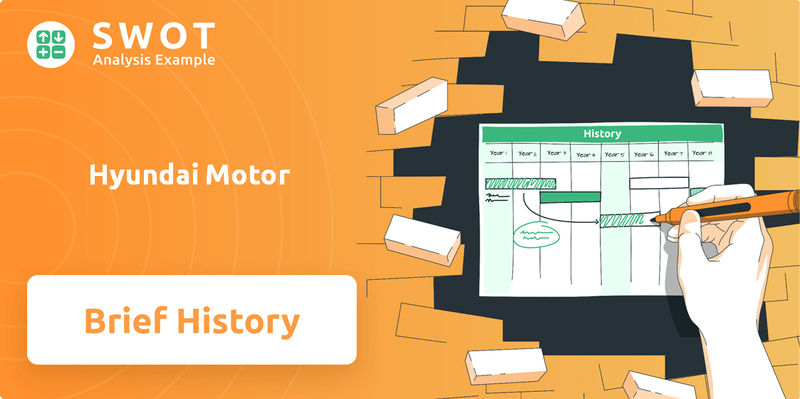
Founded in 1967, the Hyundai origin story begins with a vision to build a Korean car manufacturer. Chung Ju-yung's early days of Hyundai Motor Company were marked by a commitment to self-sufficiency, eventually leading to the creation of various Hyundai models. This dedication propelled Hyundai's expansion, transforming it into a global force and reshaping the Hyundai timeline.
What is the Hyundai Motor Founding Story?
The Hyundai Motor Company officially launched on December 29, 1967. It was the brainchild of Chung Ju-yung, who had already made a name for himself with the Hyundai Engineering and Construction Company, established back in 1947. Chung saw a big opportunity in the lack of a domestic car industry in South Korea, which meant the country was relying on expensive imports.
Chung's plan was to use the existing industrial strength of the Hyundai Group to get into car production. They started by working with others to learn the ropes. Their first 'product' wasn't a car they made from scratch, but rather, they assembled Ford Cortinas under a license starting in 1968. This gave them valuable experience in making cars.
The name 'Hyundai' itself is Korean for 'modern,' reflecting Chung's vision for a forward-thinking company. The initial funding came from the success of the Hyundai Group, giving the new venture a solid financial base. The environment at the time, with the country focused on industrialization and self-reliance, played a big role in Chung's decision to enter car manufacturing, seeing it as key to a modern economy.
Hyundai's story began with a vision to modernize South Korea's automotive landscape.
- Chung Ju-yung founded Hyundai Motor Company in 1967.
- The company initially assembled Ford Cortinas under license.
- 'Hyundai' means 'modern' in Korean, reflecting the company's aspirations.
- The Hyundai Group provided the initial financial backing.
Hyundai Motor SWOT Analysis
- Complete SWOT Breakdown
- Fully Customizable
- Editable in Excel & Word
- Professional Formatting
- Investor-Ready Format
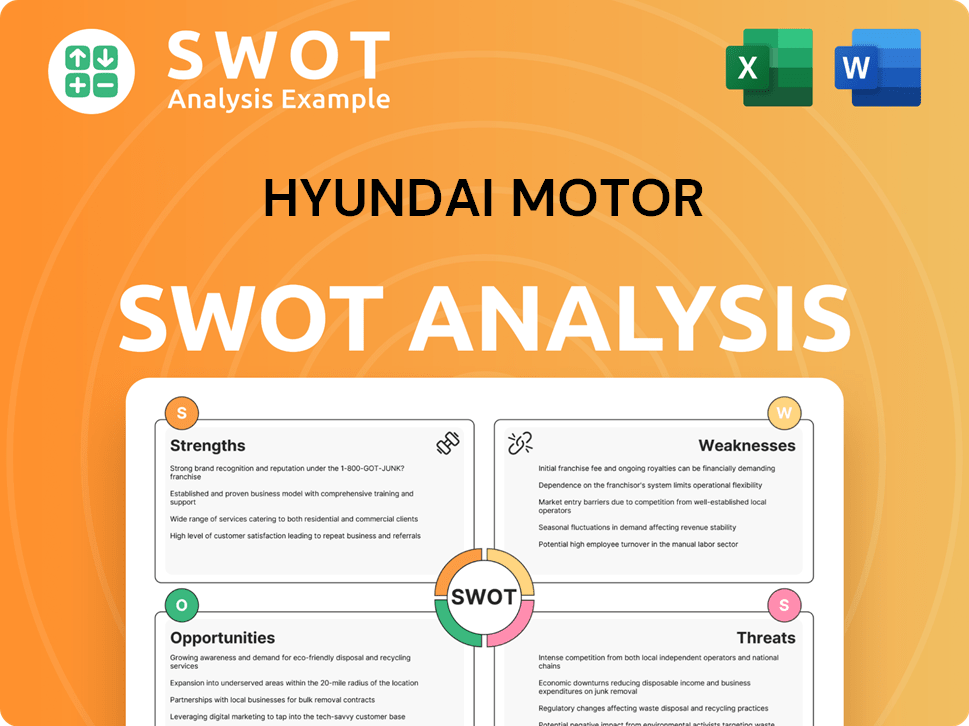
What Drove the Early Growth of Hyundai Motor?
The early growth of Hyundai Motor Company, a Korean car manufacturer, was marked by strategic acquisitions and market entries. Following its initial collaboration with Ford, the company made a crucial decision to develop its own vehicles. This ambition led to the recruitment of global automotive talent, which was pivotal to the creation of Hyundai's first car model.
The Hyundai origin story began with the Pony, introduced in 1975, which was South Korea's first mass-produced automobile. Initially aimed at the domestic market, the Pony quickly gained traction due to its affordability and suitability for local conditions. This early success laid the groundwork for Hyundai's expansion into international markets, demonstrating the company's adaptability and vision.
Hyundai history includes its entry into the Ecuadorian market in 1976, followed by significant inroads into Europe, particularly in Belgium and the Netherlands. A major turning point was its entry into the Canadian market in 1983, where the Pony became the best-selling car in its segment. This early international success proved Hyundai's ability to compete beyond its home borders.
The company expanded its manufacturing capabilities to meet growing demand, adapting its management structure to support its increasing global footprint. Market reception was initially cautious in some Western markets. However, Hyundai models differentiated themselves through aggressive pricing and a focus on reliability. This strategic shift was crucial for its early growth trajectory, helping to build a customer base against established competitors.
As Hyundai Motor Company expanded, it faced challenges from established automakers. The company's commitment to value-for-money vehicles allowed it to build a customer base. This approach helped Hyundai establish a strong presence in various markets. For more details on the company's journey, explore Owners & Shareholders of Hyundai Motor.
Hyundai Motor PESTLE Analysis
- Covers All 6 PESTLE Categories
- No Research Needed – Save Hours of Work
- Built by Experts, Trusted by Consultants
- Instant Download, Ready to Use
- 100% Editable, Fully Customizable
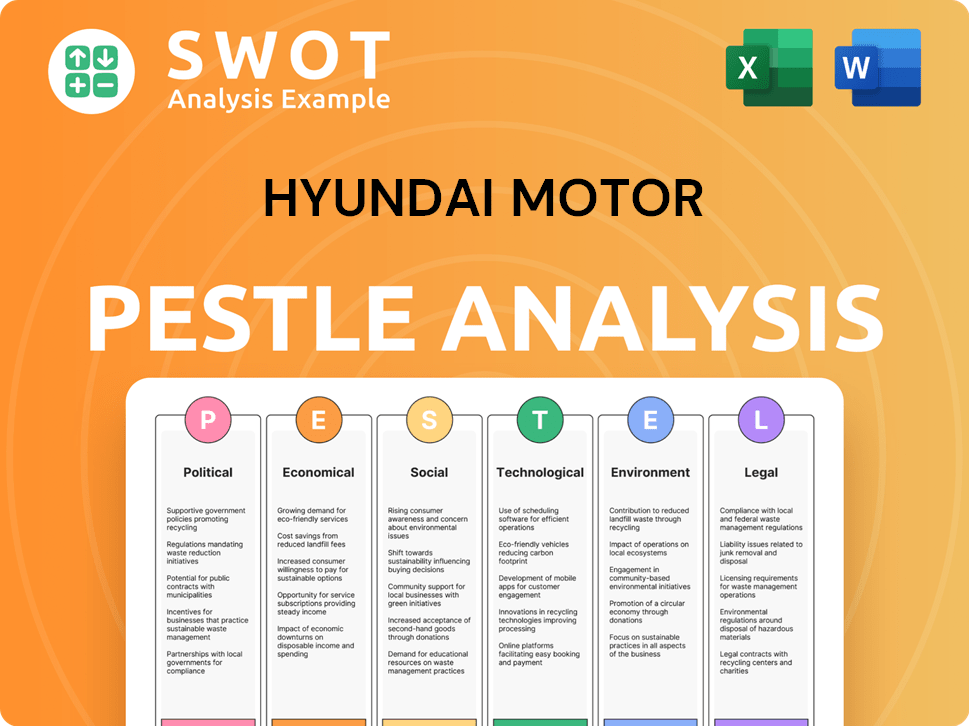
What are the key Milestones in Hyundai Motor history?
The Hyundai Motor Company's journey, from its Hyundai origin to its current global presence, is marked by significant milestones. These achievements reflect the company's evolution and its strategic responses to market dynamics and global challenges. The Korean car manufacturer has consistently adapted and innovated, solidifying its position in the automotive industry.
| Year | Milestone |
|---|---|
| 1967 | Hyundai Motor Company was founded by Chung Ju-yung, marking the beginning of its automotive endeavors. |
| 1975 | The Pony, Hyundai's first car model, was launched, signaling the company's initial foray into vehicle production. |
| 1985 | The Sonata was introduced, a key model that expanded Hyundai models' appeal and market reach. |
| 1998 | Hyundai acquired Kia Motors, forming the Hyundai Motor Group and significantly increasing its market share. |
| 1998 | Hyundai introduced a 10-year/100,000-mile powertrain warranty in the U.S., enhancing customer confidence. |
| 2021 | Hyundai launched the Ioniq 5, a significant step in its electric vehicle strategy, receiving prestigious awards. |
Hyundai has consistently pursued innovation to enhance its products and market position. The development of the Alpha engine in the early 1990s showcased Hyundai Motor Company's move towards technological independence. Furthermore, the company's investment in design centers and top talent led to vehicles with improved aesthetics and appeal.
Hyundai developed its own Alpha engine in the early 1990s, which was a significant step towards self-sufficiency.
Establishing design centers and attracting top talent led to the creation of aesthetically pleasing vehicles.
Significant investments in electric vehicle technology resulted in successful models like the Ioniq 5 and Ioniq 6.
Rigorous quality control measures were implemented to improve reliability and customer satisfaction.
Industry-leading warranties, such as the 10-year/100,000-mile powertrain warranty in the U.S., were introduced to boost consumer confidence.
Hyundai expanded its global presence, increasing its market share and brand recognition worldwide.
Hyundai Motor Company has faced several challenges throughout its history. The Asian financial crisis of the late 1990s significantly impacted the South Korean economy, necessitating restructuring. The company also had to overcome initial perceptions of lower quality, which it addressed through strategic improvements.
The Asian financial crisis of the late 1990s severely affected the South Korean economy and the automotive industry.
Initial perceptions of lower quality in some international markets presented a challenge for Hyundai.
Intense competition in the rapidly evolving electric vehicle (EV) market poses a significant challenge.
Adapting to stringent global emissions regulations is a continuous challenge for Hyundai.
Global economic fluctuations and changing consumer preferences create ongoing market volatility.
Disruptions in the global supply chain have presented challenges for production and distribution.
Hyundai Motor Business Model Canvas
- Complete 9-Block Business Model Canvas
- Effortlessly Communicate Your Business Strategy
- Investor-Ready BMC Format
- 100% Editable and Customizable
- Clear and Structured Layout
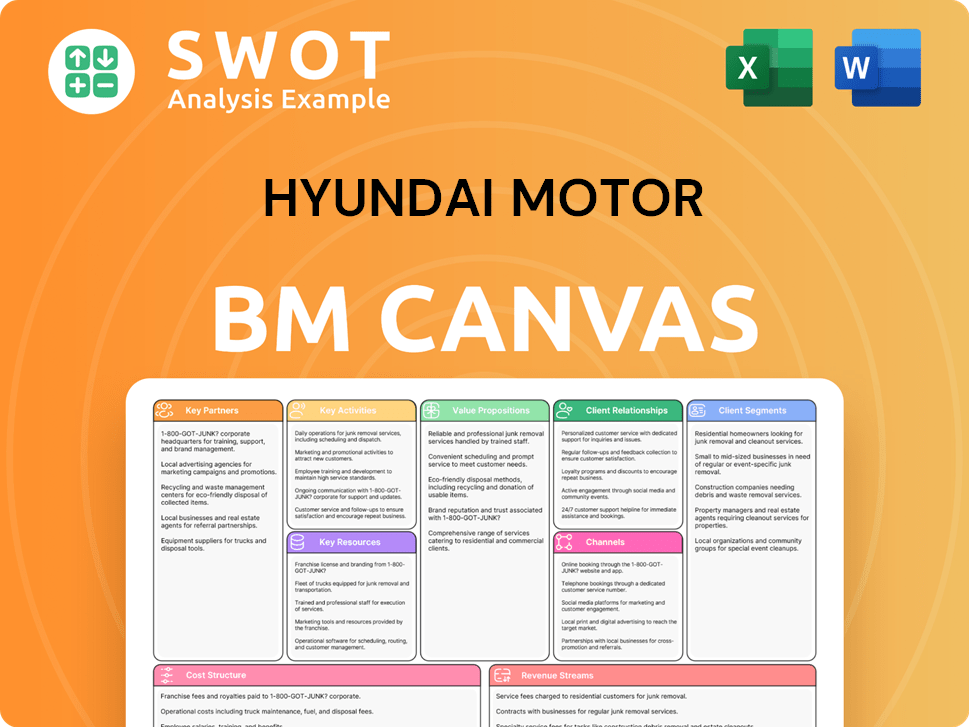
What is the Timeline of Key Events for Hyundai Motor?
The Hyundai Motor Company, a prominent Korean car manufacturer, has a rich Hyundai history, marked by strategic expansions and technological leaps. From its Hyundai origin in 1967, assembling Ford Cortinas, to its current status as a global automotive leader, the company's journey showcases remarkable growth and adaptation. Early on, it was a relatively unknown entity, but through consistent innovation, it has solidified its place in the automotive world. This Hyundai timeline highlights pivotal moments in the company's evolution, demonstrating its commitment to quality and innovation.
| Year | Key Event |
|---|---|
| 1967 | Hyundai Motor Company is founded in Seoul, South Korea. |
| 1968 | Begins assembling Ford Cortinas under license, marking an early partnership. |
| 1975 | Introduces the Pony, South Korea's first mass-produced automobile. |
| 1976 | Exports the Pony to Ecuador, entering its first international market. |
| 1983 | Enters the Canadian market with the Pony, achieving significant sales success. |
| 1985 | Launches the Sonata, a key model in its global expansion efforts. |
| 1986 | Enters the U.S. market with the Excel, a strategic move for growth. |
| 1991 | Develops its first proprietary engine, the Alpha, enhancing its technological capabilities. |
| 1998 | Acquires Kia Motors, forming the Hyundai Motor Group, expanding its market presence. |
| 2000s | Focuses on improving quality and design, leading to significant brand perception improvements. |
| 2008 | Introduces the Genesis luxury brand as a standalone division, diversifying its offerings. |
| 2010s | Begins significant investment in electric vehicle technology, anticipating future trends. |
| 2021 | Launches the Ioniq 5, a dedicated electric vehicle built on a new EV platform. |
| 2023 | Introduces the Ioniq 6, further expanding its EV lineup and market reach. |
| 2024-2025 | Continues to expand its EV and hydrogen fuel cell vehicle offerings and invests in autonomous driving technologies. |
Hyundai Motor Company aims for an EV-first strategy, targeting an annual EV sales target of 2 million units by 2030. This ambitious plan includes introducing 17 new EV models across the Hyundai and Genesis brands by the end of the decade. The company is investing heavily in EV technology to meet growing consumer demand and regulatory requirements.
Hyundai is investing heavily in advanced technologies like autonomous driving, robotics, and Advanced Air Mobility (AAM). The company is aiming to become a Smart Mobility Solution Provider, going beyond just manufacturing cars. These investments are crucial for maintaining a competitive edge in the rapidly evolving automotive industry.
Analyst predictions suggest continued strong growth in the EV segment, with models like the Ioniq series driving market share gains. The company's focus on sustainable mobility and customer-centric innovation is expected to attract a broader consumer base. The Target Market of Hyundai Motor is expanding rapidly.
Leadership emphasizes a commitment to sustainable mobility and customer-centric innovation. This forward-looking approach builds on Chung Ju-yung's founding vision of a modern, self-sufficient Korean automotive industry. Hyundai is now reimagining this vision for a global, electrified, and connected future, ensuring it remains at the forefront of automotive innovation.
Hyundai Motor Porter's Five Forces Analysis
- Covers All 5 Competitive Forces in Detail
- Structured for Consultants, Students, and Founders
- 100% Editable in Microsoft Word & Excel
- Instant Digital Download – Use Immediately
- Compatible with Mac & PC – Fully Unlocked
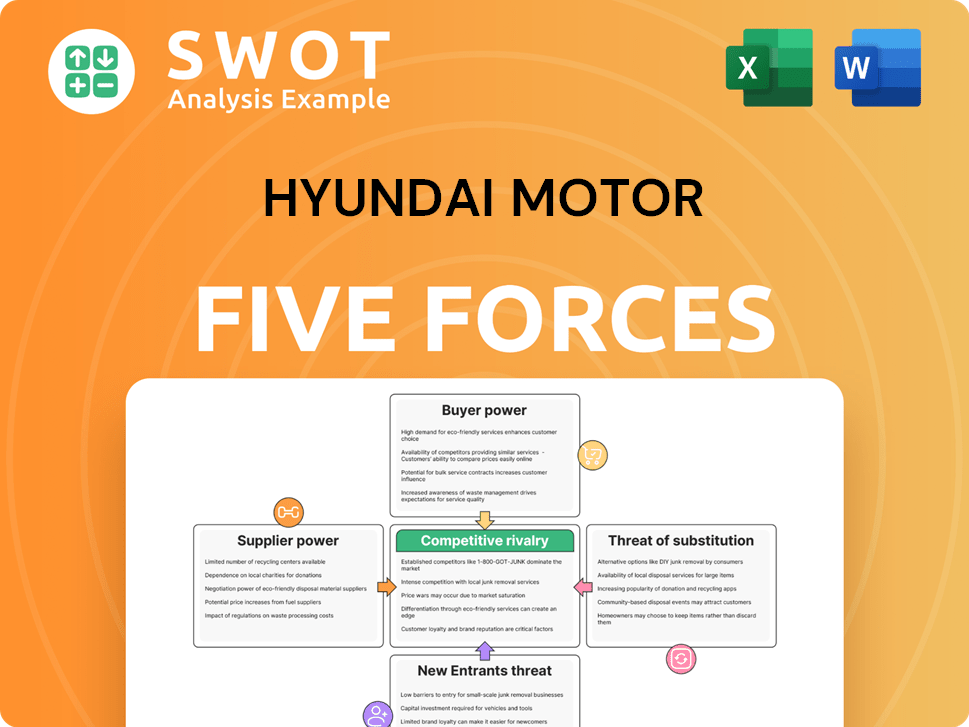
Related Blogs
- What is Competitive Landscape of Hyundai Motor Company?
- What is Growth Strategy and Future Prospects of Hyundai Motor Company?
- How Does Hyundai Motor Company Work?
- What is Sales and Marketing Strategy of Hyundai Motor Company?
- What is Brief History of Hyundai Motor Company?
- Who Owns Hyundai Motor Company?
- What is Customer Demographics and Target Market of Hyundai Motor Company?
Disclaimer
All information, articles, and product details provided on this website are for general informational and educational purposes only. We do not claim any ownership over, nor do we intend to infringe upon, any trademarks, copyrights, logos, brand names, or other intellectual property mentioned or depicted on this site. Such intellectual property remains the property of its respective owners, and any references here are made solely for identification or informational purposes, without implying any affiliation, endorsement, or partnership.
We make no representations or warranties, express or implied, regarding the accuracy, completeness, or suitability of any content or products presented. Nothing on this website should be construed as legal, tax, investment, financial, medical, or other professional advice. In addition, no part of this site—including articles or product references—constitutes a solicitation, recommendation, endorsement, advertisement, or offer to buy or sell any securities, franchises, or other financial instruments, particularly in jurisdictions where such activity would be unlawful.
All content is of a general nature and may not address the specific circumstances of any individual or entity. It is not a substitute for professional advice or services. Any actions you take based on the information provided here are strictly at your own risk. You accept full responsibility for any decisions or outcomes arising from your use of this website and agree to release us from any liability in connection with your use of, or reliance upon, the content or products found herein.